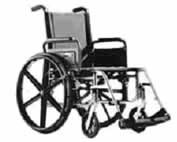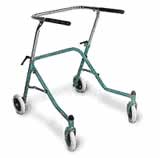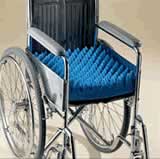DATI Assistive Technology Facts:
Seating, Positioning and Mobility
"Life is an escalator. You can move forward and backward; you
cannot remain still."
- Patricia Russell-McCloud
What is assistive technology?
Assistive technology, or AT, is any tool that allows individuals with disabilities to use their own unique abilities to reach their goals. AT can range from low-cost tools such as a jar opener to more complex devices such as a power wheelchair or communication aid.
Infants, children, adults, and older persons with any type of disability can be aided by the use of AT.
What are seating, positioning, and mobility devices?
This category includes those products that support or improve mobility, and the equipment used to customize mobility alternatives. Seating and positioning devices improve body stability, provide trunk and head support, and reduce pressure on skin. Mobility devices aid movement in space as well as movement over distance.
Who can benefit from these types of devices?
Anyone looking to improve personal mobility can benefit from this category of technology. Mobility aids can contribute to improved quality of life by enabling the person to move with greater ease and safety at home, at school, at work, and in the community. Seating and positioning equipment provides users with stability, and may facilitate improved control of head, arms, and hands. The equipment also minimizes the effects of abnormal muscle tone and may prevent injury or skeletal deformity.
What types of mobility, positioning, and seating
equipment
are available?
Mobility Equipment
- Manual wheelchair
- Electric wheelchair
- Scooter
- Cane
- Crutches
- Walker
Positioning/Seating Systems for Wheelchairs
- Cushions
- Custom-fitted systems
- Tilt and/or recline features
- Accessories like foot supports
Where can I purchase seating, positioning, and mobility devices?
While it may be tempting to select a mobility product from a catalog or TV commercial, this is unwise. It is important to find a device with features that match the user’s needs and this can only be done with an evaluation by professionals with sufficient expertise. Physical or occupational therapists, in partnership with rehabilitation technology specialists and product vendors, can help match consumer needs and preferences to products.
Following an evaluation with the team, it is likely that they will recommend one or more devices for trial use before a final recommendation is made. A physician writes a prescription for the selected product(s), and an equipment vendor will then work with the consumer and team to acquire the product and, in many cases, the third-party reimbursement for it.
From a financial and a safety standpoint, both a professional consultation and a device trial period are important steps in obtaining AT devices.
With wheelchairs, what is more important—the mobility
device
or the seating and positioning system?
The mobility device provides the user with the equipment to get from one place to another. However, the seating and positioning system allows the user to function at the highest level possible. This equipment enhances both an individuals’ comfort and safety.
What are some things I should consider before
making a purchase?
- Can I navigate my customary environments using this equipment?
- Do I need more than one kind of mobility device to help me get around?
- In what environment will I be using my equipment?
- Does my condition vary in severity from day to day?
- What funding resources are available for this purchase?
- What are my strengths, limitations, and preferences?
- Is the mobility device comfortable?
- Can I operate the selected equipment safely and well?
 |
The Quickie Breezy 500 is a lightweight, manual wheelchair. It is shown above with footrests. |
 |
The BUGSY Pediatric Walker by Otto Bock is a reverse walker for indoor and outdoor use. It is available in three sizes for children ages 2-20. |
 |
This Wheelchair Cushion by Sammons Preston Rolyan is made of deep foam that envelops bony areas to reduce pressure while preventing slippage. |
| Learn More: AT Fact Sheets | ||||
Adapted Toys |
||||
Aids for Low Vision |
||||
Aids for Daily Living |
||||
Assistive listening devices |
||||
Augmentative and Alternative Communication (AAC) |
||||
Computer Access |
||||
Seating, Position and Mobility |
Viewing |
|||
Switches and Environmental Control Units |
||||
Delaware Assistive Technology Initiative
Center for Applied Science & Engineering
University of Delaware/Alfred I. duPont Hospital for Children
PO Box 269, 1600 Rockland Road
Wilmington, DE 19899-0269
1(800) 870-DATI or (302) 651-6790
TDD: (302) 651-6794
FAX: (302) 651-6793
dati-ud@udel.edu
www.dati.org
